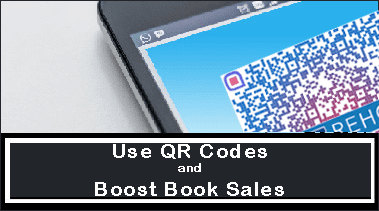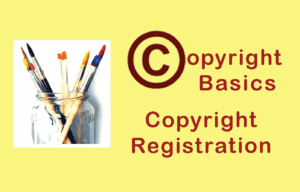A QR, quick response, code can convey a wealth of information when scanned with a smartphone, pad, or dedicated scanner. The square’s unique image transports a potential buyer to Amazon’s book page, the book’s website landing page, a book sample, or any content that convinces a reader to purchase. Learn to create and use QR codes to jack up sales.
What Are QR Codes and How Do They Work
The QR is a two-dimensional version of a barcode and stores up to 7089 digits or 4296 characters, including punctuation marks, special characters, and encoded words and phrases such as internet addresses. The unique design permits a QR with thirty percent damage to still deliver accurate information. Another plus is scanning angle and direction don’t affect the accuracy of a scan. The figure below describes how the different parts of code help to deliver the information.
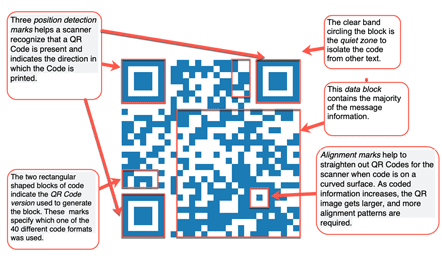
Five QR Codes—Frame QR Works Best for Authors
The original codes, Model 1 and 2, have been expanded into the four other code forms illustrated in the following figure.
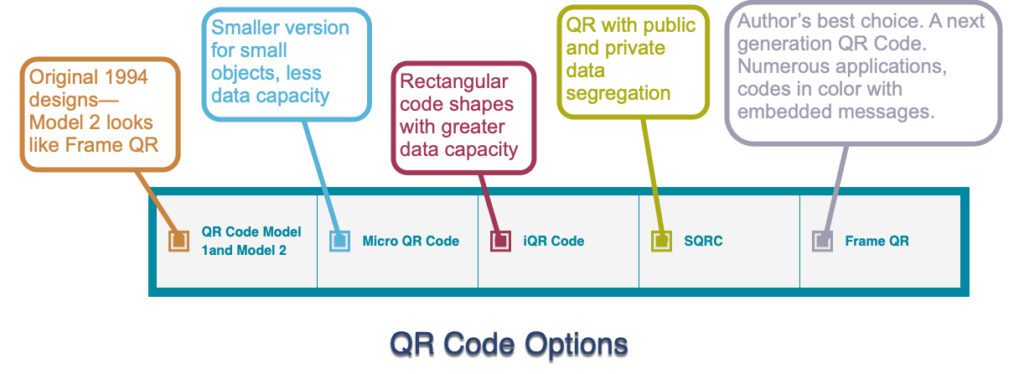
Frame QR has some useful features:
- A color palette permits selection of the code color.
- The QR allows a logo, image, or text in the canvas area.
- The center content’s size and shape is adjustable.
The figures below show some of the options for the Frame QR.
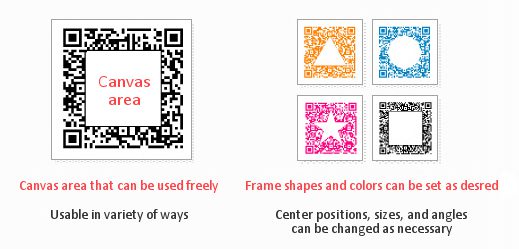
QR Code Video Demonstrates the Process
Watch the QRTiger company’s eleven-minute YouTube video and get an excellent overview of QR Codes and their applications.
QR Codes are Either Static or Dynamic
Static QR codes can’t be changed once created. A scanned static code takes users to specific data. If the redirect is to a web page, the static code will always deliver that page; however, the webpage can change as necessary. In most cases, static codes meet the needs of authors, and the code block creation is free, but consider some caveats. Because static types have the data written into the code’s image, the quantity of data dictates the size of the QR image block. A large amount of data requires a big code block for a reliable scan. Also, the scanned QR square on a book’s back cover or other printed material displays the block’s programmed content and can’t be changed.
Dynamic QRs use a short URL that links to a digital file, which can change to deliver a different message without changing the QR image. So dynamic code messages are editable. In addition, the short web link reduces the block’s image size and scan time, and dynamic codes permit the collection of tracking data. The tracking metrics include: time scanned, scan location by city or country, operating device used, and unique vs. total scans. Total scans count every scan of the code. Unique scans eliminate multiple scans from the same device or person. This information enriches the marketing campaign analytics. Established authors may find dynamic QR features useful. But the generated codes are not free and require a subscription to the application. The costs generally start at less than $5 per month.
Common Static QR Code Applications—An Author’s Free Option
Some examples of static QR codes include:
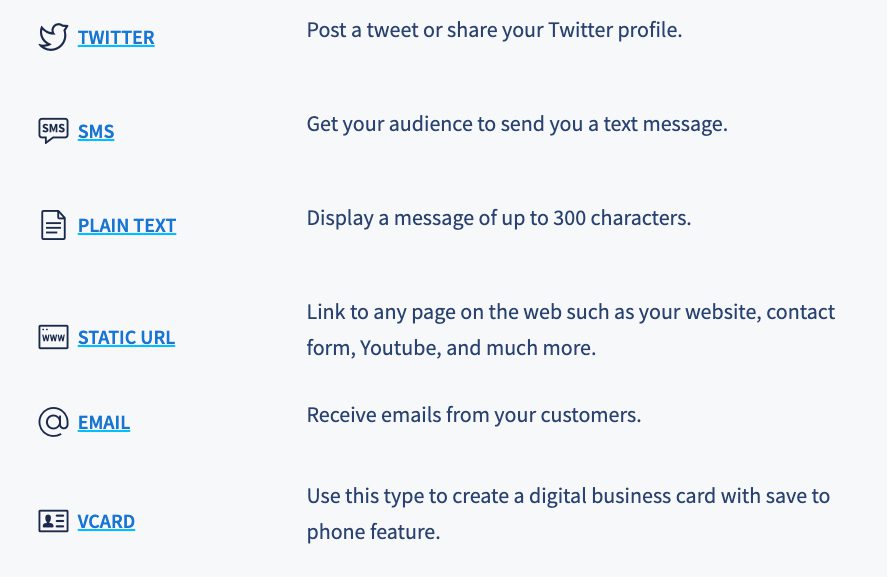
These applications could be integrated into a book launch marketing campaign to help sell more books—more on this later. For a detailed look at dynamic QR code applications, check QR Code Generator’s website.
QR Code Generator Comparisons and Recommendations
Several bloggers tested and ranked QR code generators. The post, 14 Best QR Code Generators, offers a list with free static code generates. A second post, Best QR Code generators [2021] The only list you’ll ever need! provides a second list. I tried a half dozen generators to explore this technology for my book launch. I liked three: qrcodemonkey, UnitagQR, and QRTiger.
How to Generate Static QR Codes with qrcodemonkey
The application opens with the following selection screen that includes four links to set code parameters for the selected URL code generation.
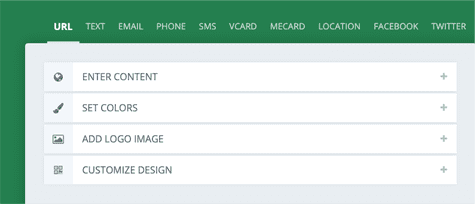
QR Code types appear across the top. This example generates a URL-type QC code. The qrcodemonkey generates the top code applications for free. The screen shows four setting selections that are opened with a left-click on the + sign.
Step 1: Fill in requested data in the Enter Content screen.
The figure below shows a URL QR code selection. This codes the URL link into the block’s graphic.
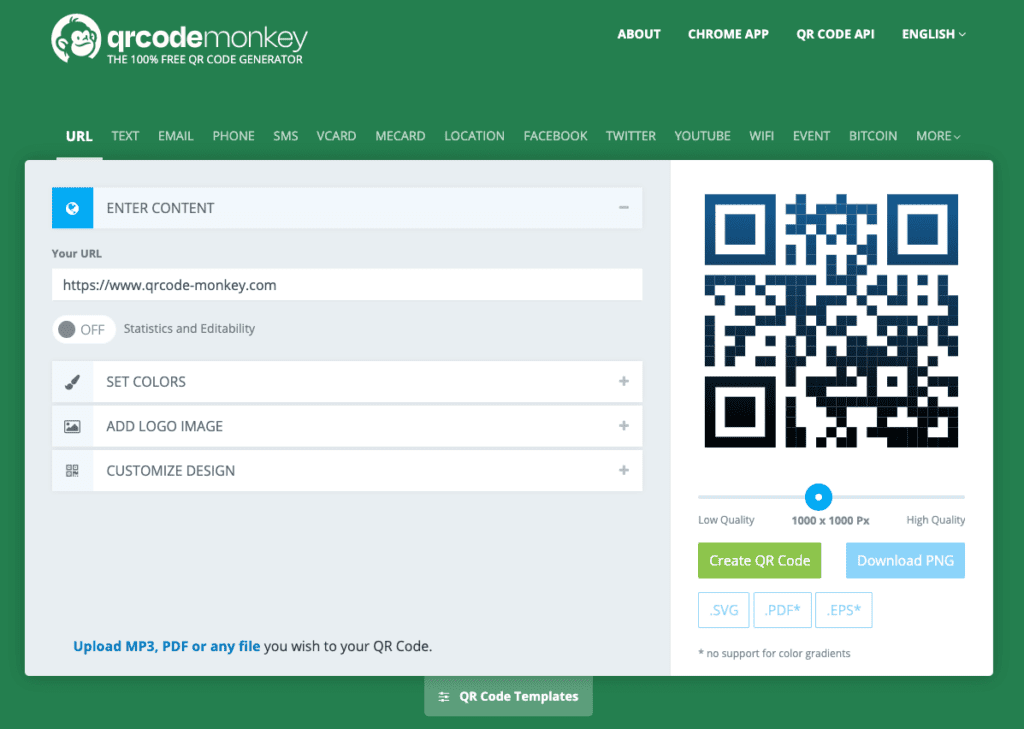
For this type of QR code, enter the URL that a scan should open. In this example, my website URL should open to the home landing page.
Step 2: Pick a template.
The template box opens with a click of the QR codes Templates button at the bottom of the image. This step is optional because a customized code for your data is produced in the following steps.
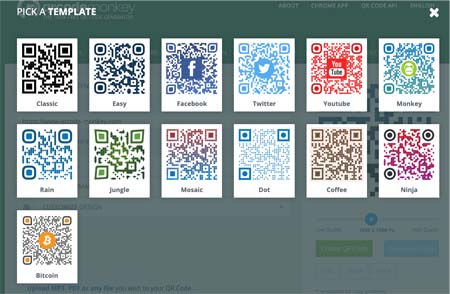
The following figure shows my URL entered into the data code generator. Note, Statistics and Editability are OFF because they require a dynamic code that is not free. A click to turn on analytics opens a popup box with registration and signup options from QR Code Generator, the company that owns qrcodemonkey.
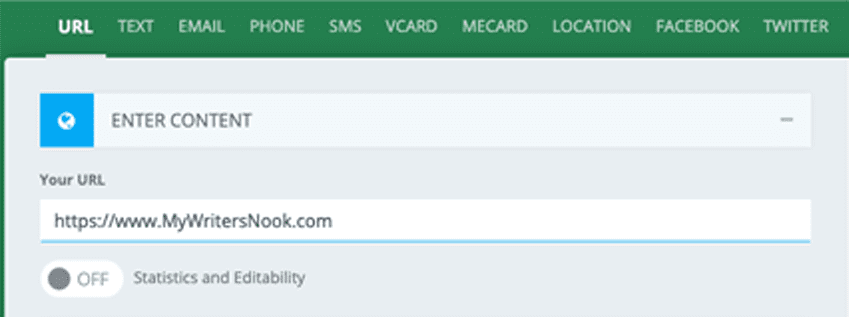
Step 3: Select the colors for the code.
The color of the code, position detection eyes, and background are user-defined with this data entry. Select the desired Foreground Color options. Click on the color blocks to open a color selector. The selected colors produce a red eye centered inside a green box. The background color is White.
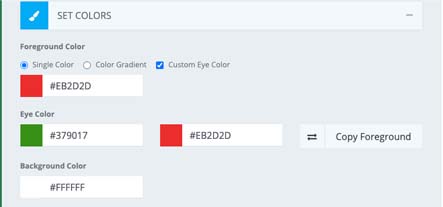
Step 4: Add a LOGO image if desired.
Some logos are listed in the popup. An upload button permits custom LOGOs from a file to appear in the block. The words, Self Publishing Help, will appear in the generated code.
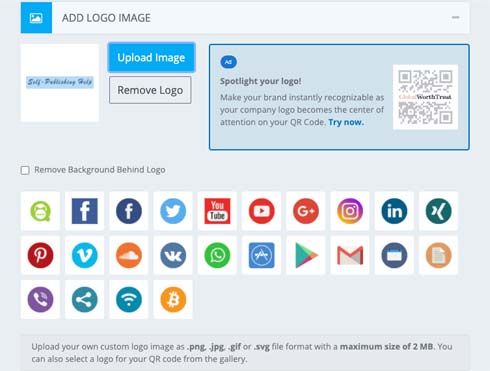
Step 5: Select the download extension and click Create QR Code.
PNG is the default file type for the graphic block, but three others are available. Choose the .SVG extension because it produces a vector graphic image of the code that improves the code’s readability.
Click on the Create QR Code button and wait for the code to appear.
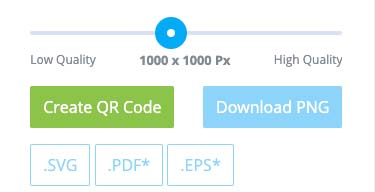
The QR Code, see the following figure, appears where the black and white sample was in the figure above. Scan the finished code to verify that it opens my website on a mobile phone.
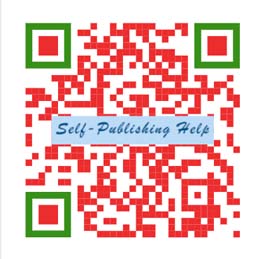
Step 7: Download the code.
Click on the Download XXX button and save the image for use in promotional documents.
The figure below has the VCard code option selected. A VCard, also known as VCF (Virtual Contact File), is a file format standard for electronic business cards. They can contain name and address information, phone numbers, e-mail addresses, URLs, logos, photographs, and audio clips in a .vcf file format. When a mobile device scans this QR code and displays contact data, the scanner has several options: Send Message, Share Contact, Create New Contact, Add to Existing Contact, Update Contact, and Share My Location. With one scan, all your information is in the scanner’s device.
Scan the QR code below to see how my contact information is quickly passed to another phone. Note also, a circular color gradient is present and different Positioning Marks are used. My branding logo is in the center.
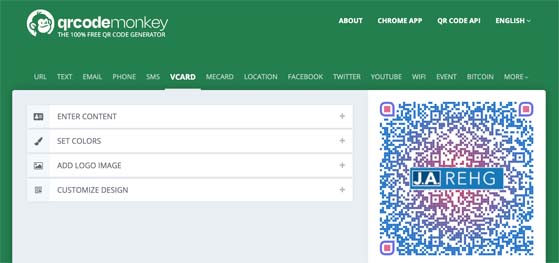
The MORE button in the application listings produces the following figure’s dropdown choices. These are dynamic codes, so a popup box from QR Code Generator appears with an invitation to pay a subscription to use these codes.
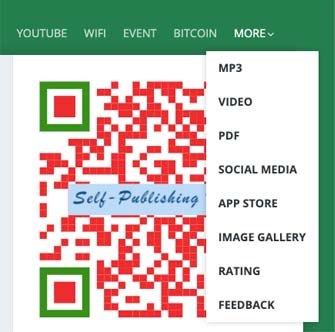
How to Generate Static QR Codes with UnitagQR
UnitagQR and QRTiger are good choices for book publishing applications; the process is similar to the qrcodemonkey steps in the exercise above. The UnitagQR process starts in number one in the figure below. There are nine types, from Web and Social Media to Wireless networks. Fill in the data boxes for code content, then customize the code, using the six settings buttons in the number two figure.
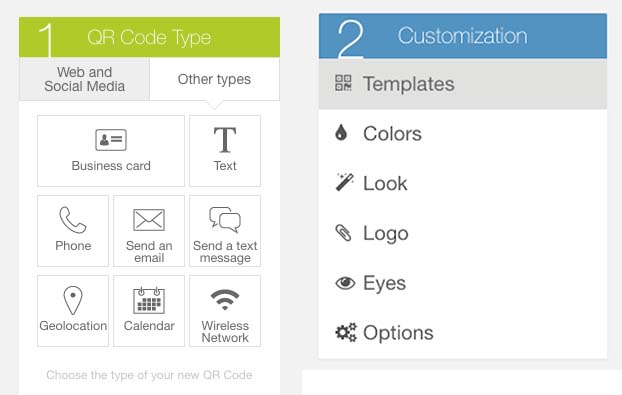
The scanned output for a Text CR code generated with UnitagQR appears in the following figure. The free generators have a maximum number of text characters with 300, a limit on some.

How to Generate Static and Dynamic QR Codes with QRTiger
This YouTube video demonstrates the code generation steps for QRTiger. Watch the video then explore this well-designed code generation site. This application offers a QR frame with customizable script, a free feature not available on the other two.
How to Scan QR Codes
A smartphone serves as a QR code scanner in most writing applications. First, verify that the phone’s Scan QR Codes option is turned on. Then move the camera toward the code until the corners of the QR square have yellow brackets. The link to the code data is saved at the top of the screen. Click the link to display the results.
To scan a QR with an iPhone camera, go to [Settings] then [Camera]. Verify that the Scan QR Codes on the iPhone Camera page has green in the Slide Switch. Version 8, 9, and 10 Android mobile devices have the native code to read QR squares. The steps to turn on the scanner vary for each phone brand. Consult this website, How to Scan QR Codes with Android Phones for the steps necessary for each type of smartphone. Another option, the Apple and Android Stores offer QR Code scanning software applications for smartphones.
QR Code Applications for Authors
Place a code on the back cover of paperbacks so potential buyers in a bookstore can link to Amazon reviews, a Youtube book trailer, or the book’s website. Add a code to any printed material: business card, bookmarks, postcards, flyers, any material where book specifics would not fit on the materials footprint.
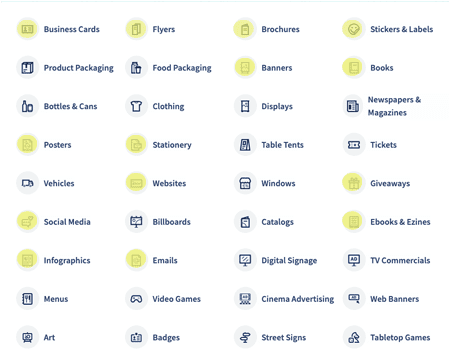
The figure above from QR Code Generators lists 36 application areas where QR Codes might apply to book marketing. Go to the Book application link. Click on the Select Other Examples button in the header to open this image. Those highlighted in yellow support book sales because potential buyers have a quick link to additional book information. Check the highlighted areas to see QR Codes embedded into products. Scan the codes on the products to see how data was formatted and displayed.
Consider the Following QR Applications to Market a Book
Code integrations for books:
- Website or web page links—redirect readers with a URL QR to an online landing page or website, Goodreads, or Amazon book page and Author Central.
- Share of personal profile or contact details—use a Vcard QR code to share your complete profile with your readers and connect with them.
- Connect with readers through media platforms—apply the Social Media QR feature to display all social media channels to readers in one scan.
- Redirect readers to an image gallery—display graphics with the H5 Editor QR and upload an image file or create a slider.
- Show a video file—apply the File QR code with a Jpeg or MP4 video file to encourage a book sale with a trailer.
- Offer an audio snippet—consider offering an audio file with the MP3 QR code.
- Book preview marketing—use a PDF QR code to feed readers to a juicy book segment, interesting passage, book preview, or teaser that creates a competitive and innovative edge for your book in the market.
Do Readers Scan QR Codes
QR Codes are not new, but they haven’t been embraced across most age groups in the US until recently. According to a study by Statista done in September 2020, 85% of respondents use QR codes, and over 30% have scanned a QR code within the last week. Thus, the use of QR codes is on the rise throughout the world. And it grew exponentially in 2020 in the US market. During the pandemic use of codes in advertising and to gather product information doubled. However, self-published authors remain in a group of under users, so adding codes to all printed material can give you an edge in the crowded published book market. Integrate them into your book marketing plan to improve customer contact and achieve more click-through sales.
I’m always interested in my reader’s projects. What are you working on? Let me know here. Leave a comment and sign up for a short monthly newsletter so you never miss an informative post.

